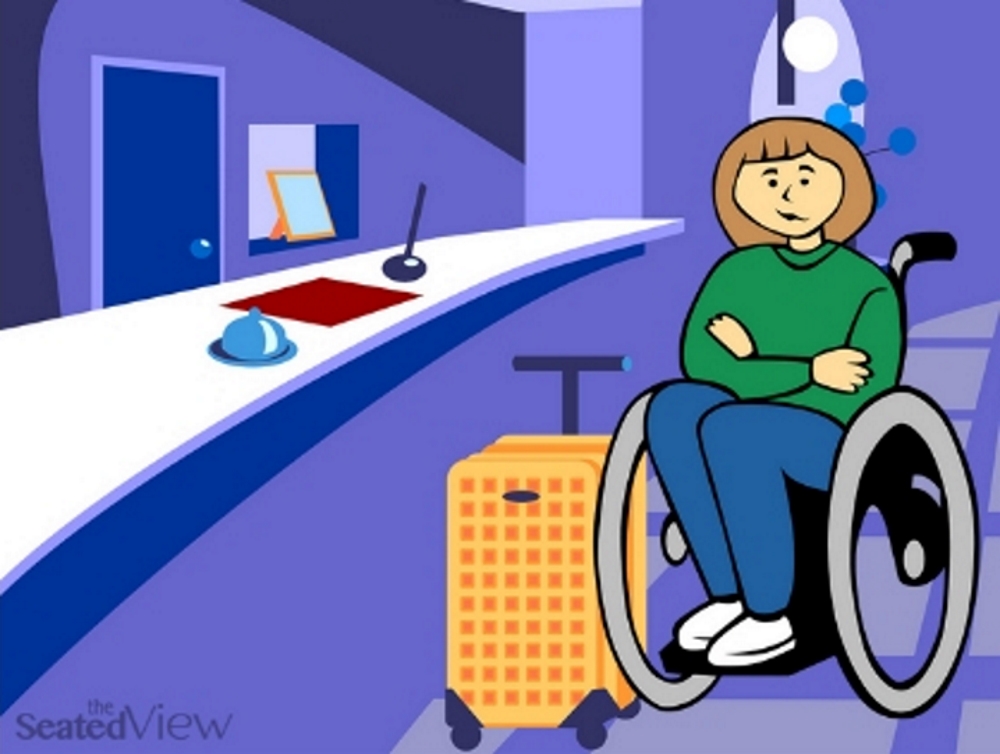Access/No Access: The Quest for an Accessible Hotel Room

I had to be out of my apartment for week while my landlord installed new flooring to replace the one that had been destroyed in a flood. But first, I decided to check out a few accessible rooms in hotels near my neighbourhood to see which would best fit my needs.
Starting with a surprise
I started at a hotel not too far from the lake, which opened just a few years ago.* What with being new, I thought it would be my best chance to find a room with a high level of accessibility.
It was not. Instead, it was a regular hotel room, with an accessible washroom. I was surprised that something so new would be so entirely lacking in access, especially regarding the bed. Not only was it difficult to get to — because: regular room — but it was also quite high.
I have previously written of the frustrations in finding a bed that was low enough for my needs. All I need is something that’s not higher than 21 inches. Based on a purely unscientific study, most of the wheelchair users I know have a wheelchair seat at about that height. A bed at about the same height as your chair is advantageous, regardless of how you transfer from chair to bed. Two inches higher or more can render it inaccessible.
The quest continues
During the months of July and August this year, I visited 22 hotels and viewed the accessible rooms in 21 of them. Without fail, any staff I encountered were universally incredibly helpful. Customer service attitudes very obviously had no barriers.
The rooms, on the other hand, were another story.
Basic features that should be included in an accessible hotel room:
- Automatic door opener (ADO) to allow for independent entrance and exit;
- Enough space to move around comfortably, including adequate turning radius;
- Accessible bathroom (roll-in shower, sink with knee clearance, and raised toilet with grab bars, automatic door opener on washroom door, or sliding or pocket door);
- Lever handles on doors, drawers and cupboards should have D handles for ease of use by people who have dexterity issues, spaces for hanging clothes should have lowered rods to allow reach by someone seated;
- Beds that can be used with a variety of transfer methods (i.e., Space next to the bed, bed no higher than approximately 21 inches, and clearance below the bed for those who use lifts).
Let’s count the ways, shall we?
Automatic door opener. Two rooms out of 21 were equipped with an ADO. One led into a medium-sized room with a king sized bed in the middle. All furniture could be moved except for the bed, meaning the person using a wheelchair would be able to use a triangle of the room. The other was on a room newly renovated to AODA standards (i.e., the room was actually accessible. Except the beds — see below).
Spacious, including adequate turning radius. A remarkably high percentage of the rooms appeared to be standard hotel rooms stuffed with furniture, including large beds, sideboards, bedside tables, etc. Someone somewhere did not understand that an accessible bathroom (see below) does not an accessible room make.
Unscented. It’s fashionable these days for establishments calling themselves boutique hotels to perfume the air with a custom scent. This excludes anyone who have medical conditions that are triggered by fragrance, such as asthma, allergies, migraines, fibromyalgia, and more.
Accessible bathroom. Bathrooms were largely not a problem. Everywhere I went, the accessible room came with a bathroom modelled on the same parameters: large rectangular room with roll-in shower on one end, sink in the middle (most with knee clearance), and a toilet with grab bars at the other end. As the bathroom features overlapped by about 90%, I believe they all followed a certain standard — perhaps AODA? Special mention: hotels that either blocked off the toilet with a glass wall and door or placed the toilet in a closet-sized room.
Usability of drawers, cupboards, doors, etc. Although most doors were equipped with lever handles, modern and sleek furniture prevailed, meaning that there were no D handles in sight, making them unusable by anyone who does not have perfect manual dexterity. A few rooms had lowered rods in spaces to allow someone in a wheelchair to hang their clothes.
Beds that do not exceed 21-22 inches. Almost all beds were minimum 23 inches, which seems to be the standard hotel room bed these days. One or two places exceeded that, getting into downright Princess and the Pea standards. Only two hotels featured beds that were at about 21 inches. Several places indicated they could lower the mattress by removing say, the boxspring, but also told me that this would likely affect comfort. As my pain levels are quite high, even on a good day, this was not a tenable solution.
The bigger picture
Imagine you’re travelling for business or pleasure to a large metropolitan city. You’ve booked a room in a lovely hotel at somewhat of a premium price, and been assured that it’s it will meet your needs. When you arrive, you find that the room doesn’t have a bed, there’s no toilet in the bathroom, or there is no room at all. And there are no other rooms available in that hotel or any other hotel in the city.
Basically, this is the situation in which a person with a disability in could very well find themselves. If you can’t access the toilet, there is no toilet in the room. If you can’t get into the bed, there is no bed in the room. If you cannot enter or exit the room independently, there is no room.
Keep in mind that we are talking about the downtown area of the metropolitan city, which translates to room charges of $300-600+. Given that most hotels — even the large ones — had designated only very few rooms to be accessible, and rent these out to able-bodied guests, it is quite likely impossible for that hypothetical guest with a disability to find an alternative.
It is absolutely astonishing to me that in 2018 I should have such trouble finding a hotel room that was actually accessible on some pretty basic criteria. It is even more astonishing to me that so many of these rooms had been designated accessible purely on the basis of having an accessible washroom, but no other accessible features.
Only three hotels had renovated their accessible rooms to conform to AODA standards, a mere 13 years after the AODA became law. How is it that the 18 others had not? How is it that they can rent these out as accessible when they are, in fact, not? And how is it that the professionals involved in designing these hotels have cleared such rooms as accessible?
*None of the hotels in this article will be named. The problems recounted in this article were too wide reaching, clearly an issue related to the industry at large, rather than individual establishments.
Tag: .disability, accessibility, accessible, accommodations, discrimination, hotels, Toronto, travel
4 Comments
Read More
Discover what else I've been writing about...
















In the US, accessibility standards are only applied when that specific room is upgraded. Many times, hotels will renovate around these rooms because they cannot usually meet the full standard. As for new buildings, the standards are not universally applied because of the variance process. Yes there are minimal levels of American with Disabilities Act (ADA) standards. Unfortunately beyond the minimal standards hotels often do not go further. It is of course a cost issue and as those standards have evolved they do not bring them up to modern standards because they do not have to do so. You gotta love capitalism sometimes.
The problem with a minimum standards is a that it’s what everyone ends up using. And minimum standards tend to be just that: minimum. Or, in other words, barely usable.
I can walk some (my primary disability is in dexterity), but struggle to stand up off of anything lower than my knees, and because mattresses sink, I need a bed that comes to mid-thigh. My own bed comes to my butt.
Because I know that it’s easier for me to get off a low bed than for a full-time wheelchair user to get into a high one, I am okay with current accessibility requirements, but accessibility isn’t the same for everyone.
You are, of course, absolutely right. My accessibility needs are different from yours, which are different from someone else’s again and this continues. It’s very difficult to balance the needs of say, wheelchair users, with the needs of people who, like you, need things to be higher. And sometimes it’s not quite that hard. Personally, I could imagine solving the problem by a hotel using beds that are at an appropriate height for wheelchair users. If someone like you came to stay, you can raise the bed by placing blocks underneath it, perhaps putting an extra boxspring or mattress on top. This accommodates both, without compromising comfort (and maybe even adding comfort if you need the extra mattress). It’s about being prepared to provide excellence in customer service, regardless of who the customer is.